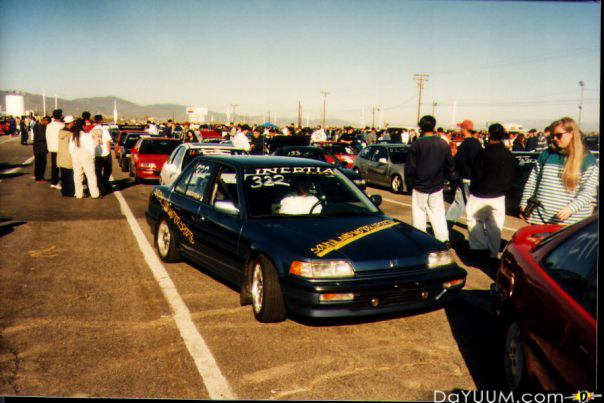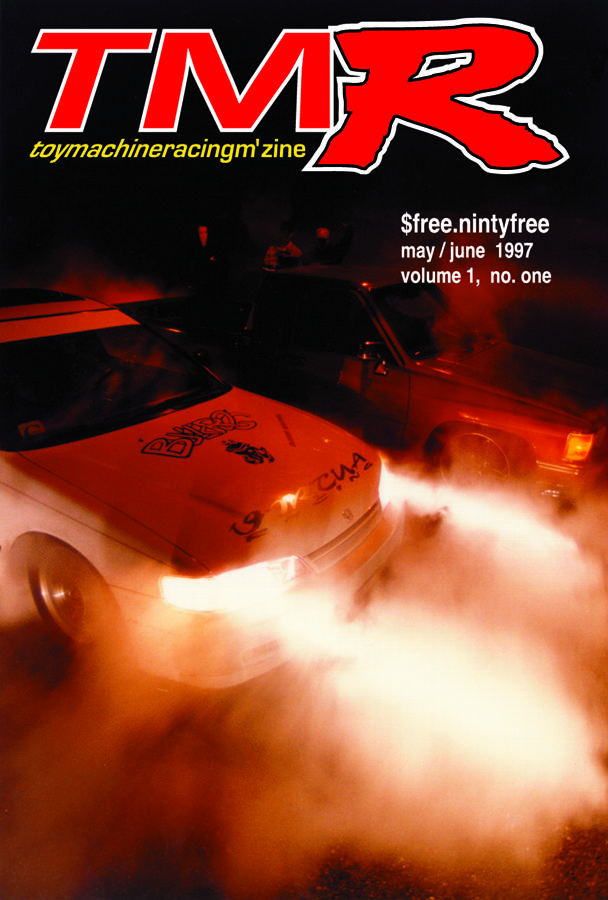Subtle Build - Reminiscing the Discovery Years.
Reminiscing the Discovery Years.Words: DennyHave you had the feeling when you get that moment? That moment you think back and recap at what had happened in your lifetime? I have been in the automotive scene for 3 decades now and have seen a lot of the progression that has become the tuner scene today. I came across a comment on @JDMWONG’s IG post, “Such a clean, subtle build!”, @eco_3 comments, on a picture of the rear drivers 3/4 of Johnathon’s EF9 on SSR SuperFins. The phrase “subtle build” kept resonating in my head.
 Then I thought, it really wasn't sublte, per say. The build was a product of the time period. In the late 80’s and early 90’s (88-92 / I am going to reference it as the “discovery years”), there weren’t any huge elaborate body kits, crazy camber, or wild vinyl graphics on sport compacts. Mugen and Kaminari was probably the most extreme body mod you could get during the time - Wings West wasn't even around yet. Fuel injected Honda and Toyotas were just scratching the surface with very little respect from the automotive scene. The scene at the time was encompassed by Mustangs, Camaros, Grand Nationals, and air-cooled VWs, all pushing big horsepower and getting down the quarter mile in 10 seconds - was the norm. The mini-truck scene was also in full swing. I have to note that the previous generation (carburetor years) we had import pioneers in 70s Datsuns, Toyotas, and Mazdas; primarily, the 510, Celica, Corolla, and RX3 paving the way for us - Shoreline Racing, respectively speaking.
Then I thought, it really wasn't sublte, per say. The build was a product of the time period. In the late 80’s and early 90’s (88-92 / I am going to reference it as the “discovery years”), there weren’t any huge elaborate body kits, crazy camber, or wild vinyl graphics on sport compacts. Mugen and Kaminari was probably the most extreme body mod you could get during the time - Wings West wasn't even around yet. Fuel injected Honda and Toyotas were just scratching the surface with very little respect from the automotive scene. The scene at the time was encompassed by Mustangs, Camaros, Grand Nationals, and air-cooled VWs, all pushing big horsepower and getting down the quarter mile in 10 seconds - was the norm. The mini-truck scene was also in full swing. I have to note that the previous generation (carburetor years) we had import pioneers in 70s Datsuns, Toyotas, and Mazdas; primarily, the 510, Celica, Corolla, and RX3 paving the way for us - Shoreline Racing, respectively speaking.
 In terms of performance, drag racing was huge. Everything was about the quarter mile and import had very little presence or respect for that matter.Until 1990, the first Battle of the Imports debut and was held in Palmdale. My car wasn’t ready yet, but I did compete in BOTI 3.
In terms of performance, drag racing was huge. Everything was about the quarter mile and import had very little presence or respect for that matter.Until 1990, the first Battle of the Imports debut and was held in Palmdale. My car wasn’t ready yet, but I did compete in BOTI 3. During the discovery years, there were limited mods for the newer fuel injected chassis. A lot of the go-fast (bolt-on) mods where being imported to the states by a few dealers, like Robocar, Promotion, DAZZ Motorsports, Han Motoring, St. Andres, and a couple others. We had picks from Mikuni, TRD, HKS, and Mugen. Domestically, we had Jackson Racing. At this point, AEM didn’t even have an intake yet and they were still a small tuner shop in Gardena with a dyno (I may get to my experience with that in a later post). To be honest, I don’t think GReddy/TRUST was even in the states yet, because I remember our buddy Dave put some money down to get a Mugen Exhaust from Robocar. After months, maybe a year, of them stroking his cock, they imported a TRUST (GReddy) exhaust instead. The exhaust at the time wasn't even for US fitment, so he had to mod the b-pipe to make it fit. It was a good sounding exhaust but built with mild steal and rusted quickly.Resources were limited, everything was word-of-mouth, hanging out at street races, or drooling over Option Magazine for cool parts only Japan had, for options that didn’t exist in the US models. But brands like Spoon, Cusco, GReddy, HKS, and Mugen were everlasting and forever impregnated in your minds. I remember when we discovered the HKS Powerflow, the sound itself was so contagious that we were all putting these green mushroom filters on the end of 10 dollar dryer hoses. I don't know why we didn’t just buy the kit or maybe the kit didn’t exist for the EF chassis in the states yet, or it costed too much money, I can't really recall. Anyways, with that intake we all thought we were “FAST”.Word on the streets was, if you had an intake, header, exhaust, lowered on cut springs, and cam(s), you were pretty much the king of the streets. If you had a 50 shot of NOS, OMG, you would be instagram famous in today’s standards. Everything was still normally aspirated during this time, turbos was only a wish at this point. I still remember walking into Turbo City in Orange and asking them if they were willing to develop a turbo kit for the Honda Civics, they chuckled at me because of the small import displacement and laughed me out the door.
During the discovery years, there were limited mods for the newer fuel injected chassis. A lot of the go-fast (bolt-on) mods where being imported to the states by a few dealers, like Robocar, Promotion, DAZZ Motorsports, Han Motoring, St. Andres, and a couple others. We had picks from Mikuni, TRD, HKS, and Mugen. Domestically, we had Jackson Racing. At this point, AEM didn’t even have an intake yet and they were still a small tuner shop in Gardena with a dyno (I may get to my experience with that in a later post). To be honest, I don’t think GReddy/TRUST was even in the states yet, because I remember our buddy Dave put some money down to get a Mugen Exhaust from Robocar. After months, maybe a year, of them stroking his cock, they imported a TRUST (GReddy) exhaust instead. The exhaust at the time wasn't even for US fitment, so he had to mod the b-pipe to make it fit. It was a good sounding exhaust but built with mild steal and rusted quickly.Resources were limited, everything was word-of-mouth, hanging out at street races, or drooling over Option Magazine for cool parts only Japan had, for options that didn’t exist in the US models. But brands like Spoon, Cusco, GReddy, HKS, and Mugen were everlasting and forever impregnated in your minds. I remember when we discovered the HKS Powerflow, the sound itself was so contagious that we were all putting these green mushroom filters on the end of 10 dollar dryer hoses. I don't know why we didn’t just buy the kit or maybe the kit didn’t exist for the EF chassis in the states yet, or it costed too much money, I can't really recall. Anyways, with that intake we all thought we were “FAST”.Word on the streets was, if you had an intake, header, exhaust, lowered on cut springs, and cam(s), you were pretty much the king of the streets. If you had a 50 shot of NOS, OMG, you would be instagram famous in today’s standards. Everything was still normally aspirated during this time, turbos was only a wish at this point. I still remember walking into Turbo City in Orange and asking them if they were willing to develop a turbo kit for the Honda Civics, they chuckled at me because of the small import displacement and laughed me out the door. Work Wheels was imported and distributed by Western Wheels Co., a wheel distribution company. Larger diameter SSRs was just hitting the streets and caused a buzz. Work and SSR were the only wheels to my knowledge that had magnetic locking caps. Work Fin and Emotion were a popular choice, until SSR took the design lead by pushing out many popular designs like the Fin, Mesh and Bang-Vec, later to be superseded by the SuperFin, SuperMesh, and Bang-Vec II.
Work Wheels was imported and distributed by Western Wheels Co., a wheel distribution company. Larger diameter SSRs was just hitting the streets and caused a buzz. Work and SSR were the only wheels to my knowledge that had magnetic locking caps. Work Fin and Emotion were a popular choice, until SSR took the design lead by pushing out many popular designs like the Fin, Mesh and Bang-Vec, later to be superseded by the SuperFin, SuperMesh, and Bang-Vec II. Companies like, DC Sports, Lightspeed, Skunkworks came many years later.
Companies like, DC Sports, Lightspeed, Skunkworks came many years later. Late 1996, Super Street Magazine debuted, and shortly before or after, Turbo Magazine put the first ever import car on the cover. In 97, there was a media outlet called TMR Magazine (Toy Machine Racing / TMRm'zine). It was a pamphlet style magazine that fit in your back pocket. It was a grassroots magazine with raw textual elements from creator, Rodney Wills. To this day, I believe it was the most “real” magazine published that wasn’t driven by massive politics and censorship.
Late 1996, Super Street Magazine debuted, and shortly before or after, Turbo Magazine put the first ever import car on the cover. In 97, there was a media outlet called TMR Magazine (Toy Machine Racing / TMRm'zine). It was a pamphlet style magazine that fit in your back pocket. It was a grassroots magazine with raw textual elements from creator, Rodney Wills. To this day, I believe it was the most “real” magazine published that wasn’t driven by massive politics and censorship.  The rest is now history.So in terms of a “subtle build”. Johnathon’s EF build was to its full potential, it was built to rule the streets and is completely period correct - for the year. It deserves to be at Peterson Museum and his EF is well preserved.Some of my timeline might be a little out of wack but this was almost 30 years ago, it’s a little hard to remember but at least I hope you could put together missing pieces of the puzzle together from other information you have gathered online. If you want to read how I got started in the automotive industry, I can get into that later. Until then. Peace
The rest is now history.So in terms of a “subtle build”. Johnathon’s EF build was to its full potential, it was built to rule the streets and is completely period correct - for the year. It deserves to be at Peterson Museum and his EF is well preserved.Some of my timeline might be a little out of wack but this was almost 30 years ago, it’s a little hard to remember but at least I hope you could put together missing pieces of the puzzle together from other information you have gathered online. If you want to read how I got started in the automotive industry, I can get into that later. Until then. Peace




